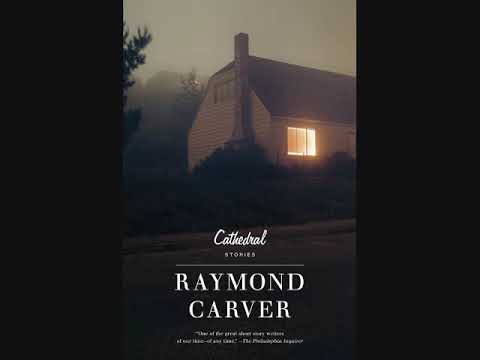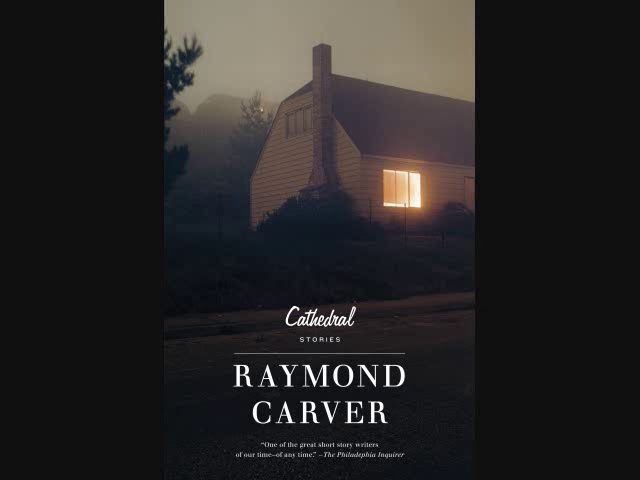Raymond Carver’s “Cathedral” Audiobook offers a profound exploration of human connection and perception. The story centers on a blind man visiting a troubled couple.
“Cathedral” by Raymond Carver is a captivating narrative that delves into themes of isolation, empathy, and personal transformation. The audiobook brings Carver’s minimalist prose to life, making it an engaging experience for listeners. Through the story of a blind man’s visit, Carver challenges the characters’ and listeners’ preconceived notions about sight and insight.
The protagonist’s journey from skepticism to understanding unfolds in a compelling and relatable manner. “Cathedral” not only entertains but also prompts deeper reflection on how we perceive and connect with others. This timeless story remains relevant, offering valuable lessons about human interaction and emotional growth.

Introduction To Raymond Carver
Raymond Carver was a master of short stories. His work has influenced many writers. The audiobook of Cathedral brings his stories to life. Let’s explore his early life and writing style.
Early Life And Influences
Raymond Carver was born in 1938 in Oregon. His family was poor. His father worked in a sawmill. Carver’s early life was tough. He worked many odd jobs to support his family.
Carver married young and had children early. He struggled with alcoholism. These experiences shaped his writing. He wrote about ordinary people facing tough times. His stories reflect real-life struggles.
Minimalist Writing Style
Carver’s writing style is minimalist. He uses simple words and short sentences. This style makes his stories powerful. Every word matters in his work.
He focuses on everyday life. His characters are often in crisis. The simplicity of his writing draws readers in. This style is perfect for audiobooks. The listener can feel the emotion in every word.
Here is a quick summary of Carver’s writing style:
- Simple words
- Short sentences
- Focus on everyday life
- Characters in crisis
Carver’s style has inspired many writers. His work remains popular today. The Cathedral audiobook is a great way to experience his stories.
The Significance Of ‘cathedral’
Raymond Carver’s “Cathedral” is a profound piece of literature. This story delves into human connection and understanding. Listening to the Cathedral audiobook offers an immersive experience. Carver’s narrative technique and vivid descriptions come to life.
Place In Carver’s Oeuvre
“Cathedral” holds a special place in Carver’s body of work. It showcases his mature storytelling style. The story marks a shift from his earlier minimalism. Carver explores deeper emotional and psychological themes here.
This story is a key part of his third major collection. It reflects Carver’s growth as a writer. “Cathedral” is often cited as his masterpiece. The audiobook captures the essence of his literary evolution.
Themes And Literary Analysis
“Cathedral” explores themes of isolation and connection. The narrator’s initial ignorance highlights human detachment. The blind man’s visit changes the narrator’s perspective. This shift represents newfound understanding and empathy.
Carver uses simple language to convey complex emotions. The story’s climax occurs during the drawing of the cathedral. This act symbolizes the breaking down of barriers. The audiobook’s narration enhances these thematic elements.
The story also examines the power of art and imagination. The act of drawing the cathedral becomes transformative. It reveals the narrator’s inner world and growth. Carver’s use of dialogue is particularly noteworthy.
| Theme | Description |
|---|---|
| Isolation | The narrator feels disconnected from those around him. |
| Connection | The narrator learns to connect with the blind man. |
| Transformation | The drawing of the cathedral changes the narrator’s view. |
Listening to the Cathedral audiobook is a unique experience. It brings out the nuances of Carver’s writing. The voice narration adds depth to the characters. This makes the story even more impactful.
Audiobook Adaptation
Raymond Carver’s “Cathedral” has captivated readers for decades. Now, it reaches new audiences as an audiobook. The audiobook adaptation process brings fresh life to this beloved short story. Let’s explore how this transition unfolds.
From Text To Audio: The Process
Transforming a written story into an audiobook is a detailed task. It involves several steps to ensure quality and engagement.
- Script Preparation: The text is reviewed and formatted for audio.
- Casting: Selecting the right voice actors is crucial for character authenticity.
- Recording: Professional studios are used to capture clear and crisp audio.
- Editing: Audio engineers remove errors and ensure smooth transitions.
- Final Review: The completed audiobook is reviewed for consistency and quality.
Voice Acting And Narration
The heart of any audiobook is its voice acting and narration. This brings characters to life and maintains listener interest.
| Aspect | Details |
|---|---|
| Narrator Selection | Choosing a voice that matches the story’s tone is key. |
| Character Voices | Actors give distinct voices to each character. |
| Emotion and Intonation | Expressive reading enhances the listener’s experience. |
Listeners can enjoy Raymond Carver’s “Cathedral” through a new lens with the audiobook. This adaptation process and professional voice work bring the story to life in unique ways.

Impact Of Narration
The narration in Raymond Carver’s Cathedral audiobook enhances the story. It brings depth and emotion. Let’s explore how narration impacts the listening experience.
The Role Of Tone And Pace
The tone of the narrator sets the mood. A calm tone can make the story soothing. A tense tone can create suspense. The pace of narration is also crucial. A slow pace allows listeners to absorb the details. A fast pace can build excitement. Together, tone and pace shape the listener’s experience.
Creating Atmosphere Through Sound
Sound effects in the audiobook add another layer. Background noises can make scenes feel real. Music can enhance the emotional impact. The narrator’s voice can convey different characters. This creates a rich auditory landscape. Listeners can feel immersed in the story.
| Element | Effect |
|---|---|
| Tone | Sets the mood |
| Pace | Controls excitement |
| Sound Effects | Creates realism |
| Music | Enhances emotion |
In Raymond Carver’s Cathedral, the narration transforms the story. It makes the audiobook a unique experience. The right tone, pace, and sound can captivate listeners.
Exploring The Characters
The characters in Raymond Carver’s “Cathedral” are rich and engaging. The audiobook brings them to life, making their development palpable. Let’s delve into the depth of these characters and how they contribute to the story’s impact.
The Narrator’s Development
The narrator starts as a cynical and insensitive man. He is uncomfortable with his wife’s blind friend visiting. His discomfort stems from ignorance and prejudice. Over the course of the story, he undergoes a significant transformation.
Key Points:
- The narrator is initially dismissive and self-absorbed.
- He feels threatened by the blind man’s visit.
- His attitude changes after drawing a cathedral together.
Drawing the cathedral becomes a pivotal moment. It opens his eyes to new perspectives. This activity helps him connect with the blind man. It also marks a major shift in his character.
The Blind Man’s Perspective
Robert, the blind man, is a key figure in the story. Despite his blindness, he sees more than the narrator. He is open-minded, kind, and insightful. He teaches the narrator to look beyond the surface.
Key Points:
- Robert is empathetic and understanding.
- He uses touch and listening to navigate the world.
- His interaction with the narrator is transformative.
Robert’s presence challenges the narrator’s narrow views. His way of experiencing life is profound. He helps the narrator see the world differently. Their interaction is the heart of the story.
Imagery And Symbolism
In Raymond Carver’s “Cathedral,” imagery and symbolism play crucial roles. They help to convey deeper meanings and enhance the reader’s experience. Through vivid descriptions and symbolic elements, Carver creates a rich, multi-layered narrative.
The Cathedral As A Motif
The cathedral in Carver’s story is more than just a building. It represents deeper themes of faith and connection. The cathedral stands as a symbol of a place where people come together. It signifies unity and shared experience.
For the blind man, the cathedral is a way to connect. He uses it to bridge the gap between him and the narrator. The narrator learns to see beyond physical sight through drawing the cathedral. This act becomes a powerful shared experience.
Sight Versus Insight
Sight versus insight is a central theme in “Cathedral.” The narrator can see but lacks understanding. The blind man, Robert, cannot see but has deep insight. This contrast highlights the difference between physical sight and true understanding.
The narrator’s journey is a transformation. He moves from being closed-minded to gaining insight. Drawing the cathedral helps him to see with his heart, not just his eyes. This act of drawing becomes a moment of epiphany for the narrator.
Ultimately, Carver uses imagery and symbolism to explore these themes deeply. The cathedral and the concept of sight versus insight enrich the story, making it a powerful narrative.
Critical Reception
Raymond Carver’s “Cathedral” has seen widespread acclaim since its release. The audiobook version has only enhanced its reach. Both literary critics and readers have shared their thoughts. Below, we delve into their insights.
Literary Critics On ‘cathedral’
Many literary critics have praised “Cathedral” for its rich storytelling and emotional depth. The narrative style stands out, drawing listeners into each scene.
Critics also highlight Carver’s minimalist approach. This style allows for deep connections with the characters. The audiobook brings this to life through its engaging narration.
Several reviews mention the audiobook’s ability to make Carver’s words more impactful. The voice actors add a layer of emotion that the printed text alone might not convey.
Public And Scholarly Response
The public’s response to “Cathedral” has been overwhelmingly positive. Many listeners appreciate the accessibility of the audiobook format. It allows them to enjoy the stories on the go.
Reviews on platforms like Audible and Goodreads often highlight the narration quality. Users frequently mention how the audiobook enhances their understanding of the text.
| Platform | Rating | Comments |
|---|---|---|
| Audible | 4.7/5 | Engaging and emotional narration. |
| Goodreads | 4.5/5 | Deep and meaningful stories. |
Scholarly articles also discuss “Cathedral” in depth. Academics often focus on its thematic elements. They analyze its symbolism and character development.
Some scholars argue that the audiobook format helps in better understanding these themes. The oral delivery can highlight nuances that might be missed in reading.

Audiobook Versus Text
Raymond Carver’s “Cathedral” is a celebrated short story. The audiobook version offers a different experience from reading the text. Let’s explore the differences and advantages of each medium.
The Experience Of Listening
Listening to the Cathedral audiobook brings the story to life. The narrator’s voice adds emotion and depth. This can make the story more engaging and easier to follow.
For those with busy schedules, audiobooks offer convenience. You can listen while driving, cooking, or exercising. This flexibility makes it easier to enjoy literature.
Audiobooks can also help with comprehension. Hearing the story can clarify difficult words and phrases. This is especially helpful for young readers or those learning English.
Comparative Analysis Of Mediums
| Aspect | Audiobook | Text |
|---|---|---|
| Accessibility | Can listen anywhere | Requires reading time |
| Engagement | Voice adds emotion | Imagination creates emotion |
| Comprehension | Helps with difficult words | May need re-reading |
Both mediums offer unique benefits. Audiobooks provide convenience and enhanced emotion. Texts allow for deeper analysis and personal interpretation.
Consider your preferences and lifestyle. Choose the medium that best fits your needs.
Accessing ‘cathedral’ Audiobook
Raymond Carver’s “Cathedral” is a masterpiece. An audiobook version makes it even more accessible. This section guides you on how to find and listen to the “Cathedral” audiobook.
Platforms And Availability
The “Cathedral” audiobook is available on multiple platforms. Here are some popular options:
| Platform | Availability |
|---|---|
| Audible | Subscription-based, with a free trial available. |
| Google Play Books | Purchase required, often with discounts. |
| Apple Books | Available for purchase, compatible with Apple devices. |
| Libby by OverDrive | Free with a library card. |
A Guide To Listening
Listening to the “Cathedral” audiobook is simple and enjoyable. Follow these steps:
- Choose a platform: Decide where you want to get the audiobook.
- Create an account: Sign up if the platform requires it.
- Search for “Cathedral”: Use the search function to find the audiobook.
- Purchase or borrow: Buy the audiobook or borrow it with a library card.
- Download the book: Ensure it’s available offline for uninterrupted listening.
- Find a quiet space: Choose a spot where you can listen without distractions.
- Use headphones: Enhance your experience by using quality headphones.
Listening to Raymond Carver’s “Cathedral” can be a profound experience. Whether at home or on the go, the audiobook offers flexibility and convenience.
Conclusion
Raymond Carver’s “Cathedral” audiobook offers a profound listening experience. This timeless story captivates listeners with its depth. Perfect for fans of literary fiction, the audiobook brings Carver’s words to life. Dive into this compelling narrative and discover why “Cathedral” remains a beloved classic.
Enjoy the journey through Carver’s unique storytelling.



